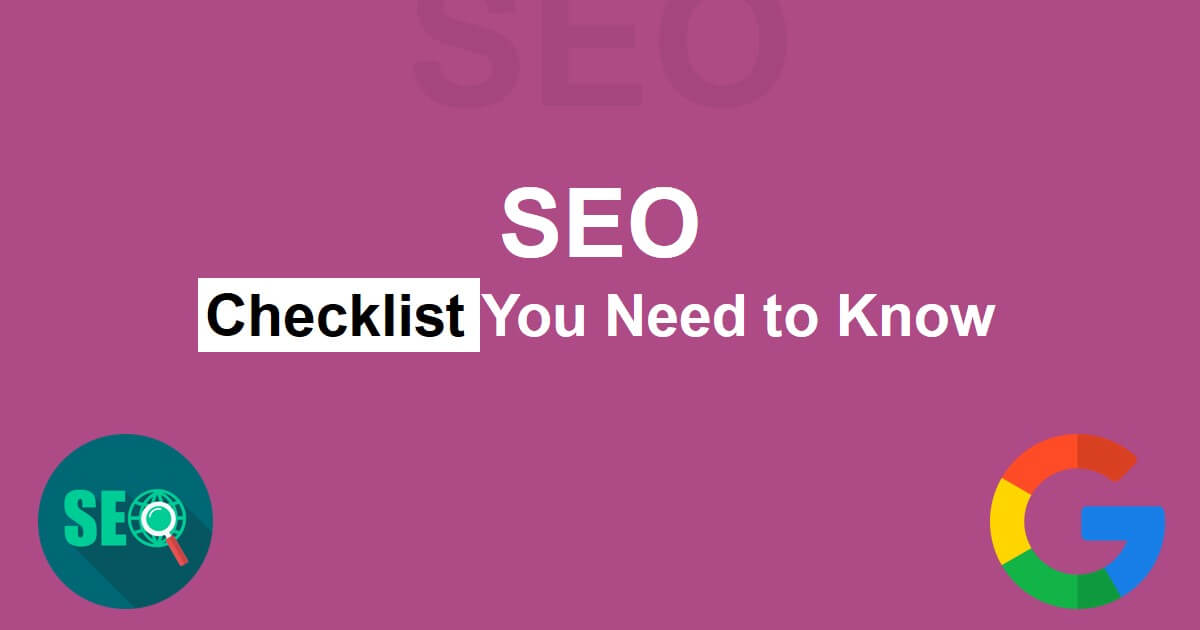
The Ultimate SEO Checklist: Boost Your Website’s Visibility
In the vast world of the internet, standing out can be tough. But fear not! With the right SEO (Search Engine Optimization) checklist, you can make sure your website gets the attention it deserves. Whether you’re a seasoned pro or just starting, this guide will walk you through the essentials step by step.
SEO Basics:
- Harness the Power of Webmaster Tools: Google Search Console (GSC) and Bing Webmaster Tools serve as your virtual compasses in the vast expanse of the internet. These tools provide invaluable insights into your website’s performance, indexing status, and any potential issues that may hinder its visibility.
- Unlock the Secrets of Google Analytics: Dive deep into the analytics of your website to gain a profound understanding of your audience’s behavior, preferences, and demographics. Armed with this knowledge, you can tailor your SEO strategies to resonate with your target audience effectively.
- Embrace the Convenience of SEO Plugins: For WordPress users, plugins like Yoast SEO or Rank Math streamline the optimization process, offering intuitive guidance on keyword usage, content readability, and technical SEO elements.
- Lay the Foundation with Sitemaps and Robots.txt: Submitting a sitemap to search engines provides them with a structured roadmap of your website’s content, facilitating efficient indexing. Meanwhile, a well-crafted robots.txt file directs search engine crawlers on which pages to crawl and which to ignore.
- Vigilance against Manual Actions: Regularly monitor Google Search Console for any manual actions or penalties imposed on your site, addressing them promptly to maintain its search visibility.
- Confirm Indexing Status: Ensure that your website’s pages are indexed by search engines, allowing them to appear in search results and reach your target audience effectively.
Keyword Research:
- Competitor Analysis: The Gateway to Success: Identify your competitors in the digital arena and dissect their SEO strategies to glean valuable insights. Analyze their keyword targeting, content quality, and backlink profiles to uncover opportunities for improvement.
- Mind the Gap: Conduct a Keyword Gap Analysis: Identify keywords that your competitors are ranking for but you’re not, and vice versa. This analysis provides fertile ground for uncovering untapped keyword opportunities and refining your SEO strategy accordingly.
- Unearth the ‘Money’ Keywords: These are the golden nuggets of SEO – high-volume keywords directly related to your products, services, or industry. Targeting these keywords can yield substantial organic traffic and conversions for your website.
- Delve into the World of Long-Tail Keywords: While broad keywords may boast high search volumes, long-tail keywords offer specificity and relevance, catering to users with more refined search intent. Leverage long-tail variations to capture niche audiences and drive targeted traffic to your site.
- Answer the Call of Question Keywords: Anticipate and address the queries that your target audience is typing into search engines. By optimizing your content for question-based keywords, you position yourself as a valuable resource and attract users seeking answers.
- Decode Search Intent: Understanding the underlying intent behind search queries is paramount to crafting relevant and engaging content. Whether informational, transactional, or navigational, align your content with the user’s search intent to enhance its visibility and utility.
- Craft a Strategic Keyword Map: Organize your keywords into a cohesive map, assigning them to relevant pages or sections of your website. This structured approach ensures comprehensive coverage of your target keywords across your site’s content hierarchy.
Technical SEO:
- Harness the Power of ‘Inspect URL’: Google Search Console’s ‘Inspect URL’ feature enables you to scrutinize individual pages for indexing issues, crawl errors, and other technical hiccups. Addressing these issues promptly ensures optimal visibility and accessibility for your content.
- Embrace Mobile-Friendly Design: With mobile devices accounting for a significant portion of web traffic, prioritizing mobile-friendliness is non-negotiable. Adopt responsive design principles to ensure seamless user experiences across all devices and screen sizes.
- Speed Matters: Optimize Page Loading Times: In the fast-paced digital landscape, every second counts. Optimize your website’s loading speed to minimize bounce rates, enhance user satisfaction, and curry favor with search engine algorithms.
- Secure Your Site with HTTPS: Security is paramount in the digital age, and HTTPS encryption is a non-negotiable aspect of website security. Secure your site with HTTPS to safeguard sensitive user data and earn the trust of both visitors and search engines.
- Navigate the Maze of Crawl Errors: Regularly audit your website for crawl errors, broken links, and other technical glitches that may impede search engine crawlers’ progress. Rectifying these issues promptly ensures smooth navigation and indexing of your site’s content.
- Combat the Specter of Duplicate Content: Duplicate content can dilute your site’s visibility and undermine its credibility in the eyes of search engines. Implement measures to address duplicate content issues and maintain the integrity of your site’s content.
- Architect SEO-Friendly URL Structures: Craft clean, descriptive URLs that succinctly convey the content and context of your web pages. A well-structured URL not only enhances user experience but also signals relevance and hierarchy to search engine crawlers.
On-Page and Content:
- Optimize Title Tags and Meta Descriptions: Your title tags and meta descriptions serve as the first point of contact between your website and search engine users. Craft compelling, keyword-rich titles and descriptions that entice clicks and accurately reflect the content within.
- Banish the Curse of Multiple H1 Tags: Maintain structural integrity and clarity in your HTML markup by adhering to the cardinal rule of one H1 tag per page. Consistent and hierarchical heading usage enhances readability and signals topical relevance to search engines.
- Conduct a Content Audit and Pruning: Regularly assess the performance and relevance of your website’s content inventory through comprehensive content audits. Identify underperforming or outdated content and either revitalize, consolidate, or retire it to streamline your site’s content portfolio.
- Optimize Images for SEO: Images are not only visual assets but also valuable opportunities to enhance your website’s SEO. Optimize image filenames, alt text, and captions to improve accessibility, relevance, and discoverability in image search results.
- Embrace the Power of Topic Clusters: Organize your content into cohesive topic clusters or content silos centered around core thematic pillars. This strategic approach fosters topical authority, enhances internal linking, and strengthens your site’s overall SEO footprint.
- Mitigate the Threat of Keyword Cannibalization: Beware of inadvertently competing with yourself for keyword rankings across multiple pages of your site. Conduct thorough keyword mapping exercises and implement targeted optimization strategies to mitigate the risk of keyword cannibalization.
- Elevate Content Readability: User experience and readability are paramount considerations in the realm of SEO. Leverage readability-enhancing techniques such as concise writing, scannable formatting, and multimedia integration to engage users and satisfy search engine algorithms.
Off-Page SEO:
- Unlock the Secrets of Competitor Link Profiles: Gain valuable insights into your competitors’ backlink strategies and unearth potential link acquisition opportunities. Analyze the quality, quantity, and relevance of their backlink profiles to inform and refine your own link-building efforts.
- Conduct a Link Intersect Analysis: Identify websites that are linking to your competitors but not to your own site. This analysis unveils untapped link-building prospects ripe for outreach and collaboration.
- Reclaim Lost Links through Broken Backlink Targeting: Monitor your competitors’ backlinks for instances of broken or defunct links pointing to valuable content. Reach out to webmasters and offer your relevant, high-quality content as a replacement, reclaiming lost link equity in the process.
- Harness the Potential of Digital PR: Cultivate relationships with journalists, bloggers, and influencers within your niche to amplify your online presence and earn authoritative backlinks. Strategic PR initiatives such as press releases, guest blogging, and expert interviews can garner valuable media coverage and inbound links.
- Ascend to New Heights with the Skyscraper Technique: Elevate your content marketing efforts by creating exceptional, high-value content that surpasses existing industry benchmarks. By identifying popular topics and improving upon them with comprehensive, authoritative content, you can attract organic backlinks and establish thought leadership in your niche.
- Convert Unlinked Mentions into Backlinks: Monitor online mentions of your brand, products, or content and reach out to the respective authors or publishers to request inclusion of backlinks where appropriate. Transforming unlinked brand mentions into valuable backlinks enhances your site’s authority and visibility in search results.
- Optimize Google Business Profile for Local SEO: Strengthen your online presence in local search results by optimizing your Google Business Profile. Ensure accuracy and completeness of your business information, encourage customer reviews and ratings, and leverage geo-specific keywords to enhance local visibility.
Steering Towards SEO Success in the Digital Era
By systematically implementing the strategies outlined in this comprehensive SEO checklist, you can empower your website to ascend the ranks of search engine results and claim its rightful place in the digital spotlight. Remember, SEO is not a one-time endeavor but an ongoing journey of optimization and adaptation to ever-evolving search algorithms and user behaviors. Stay vigilant, stay informed, and reap the rewards of a finely-tuned SEO strategy that drives sustainable organic growth and visibility for your website.

This post has 2 Comments